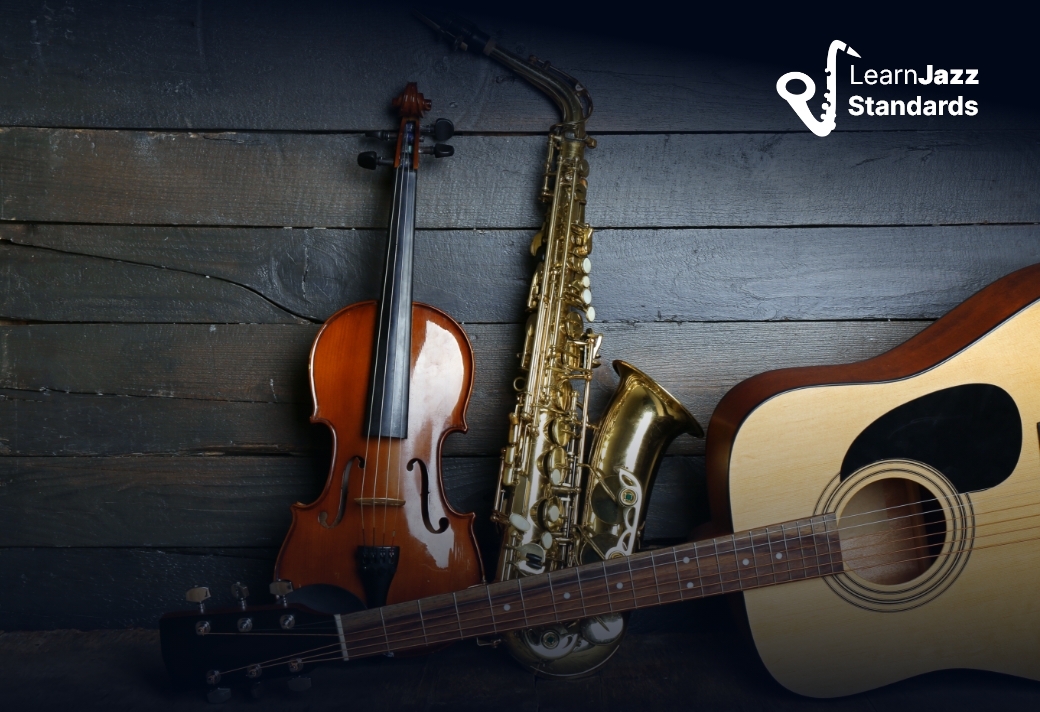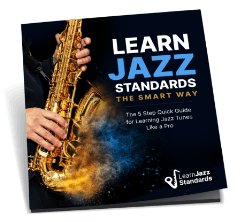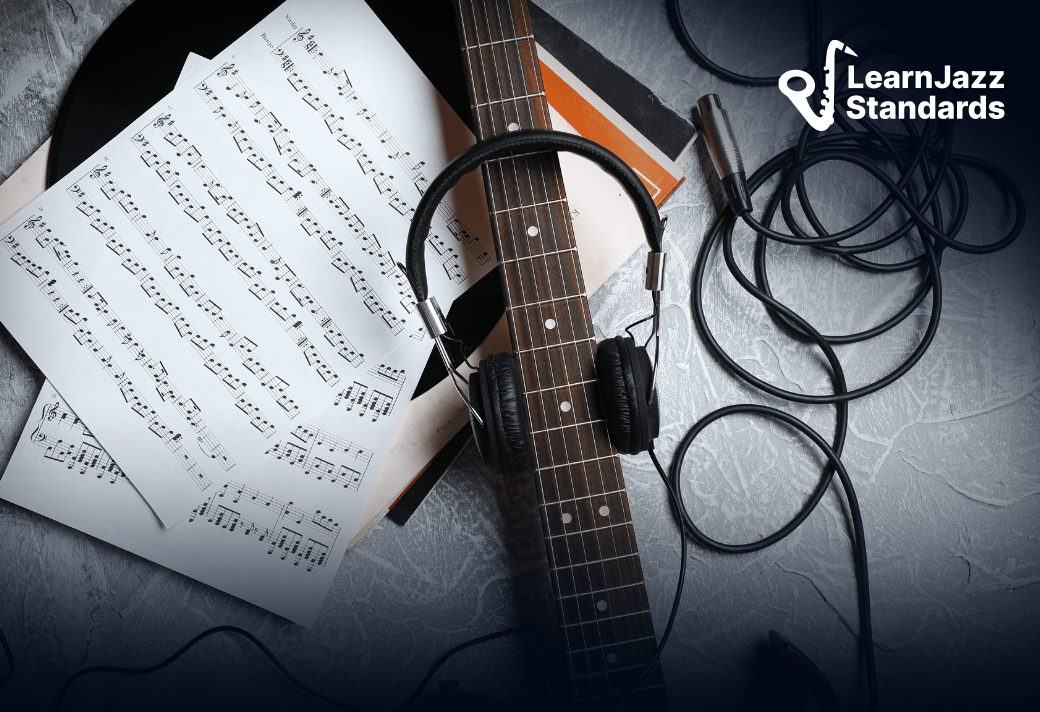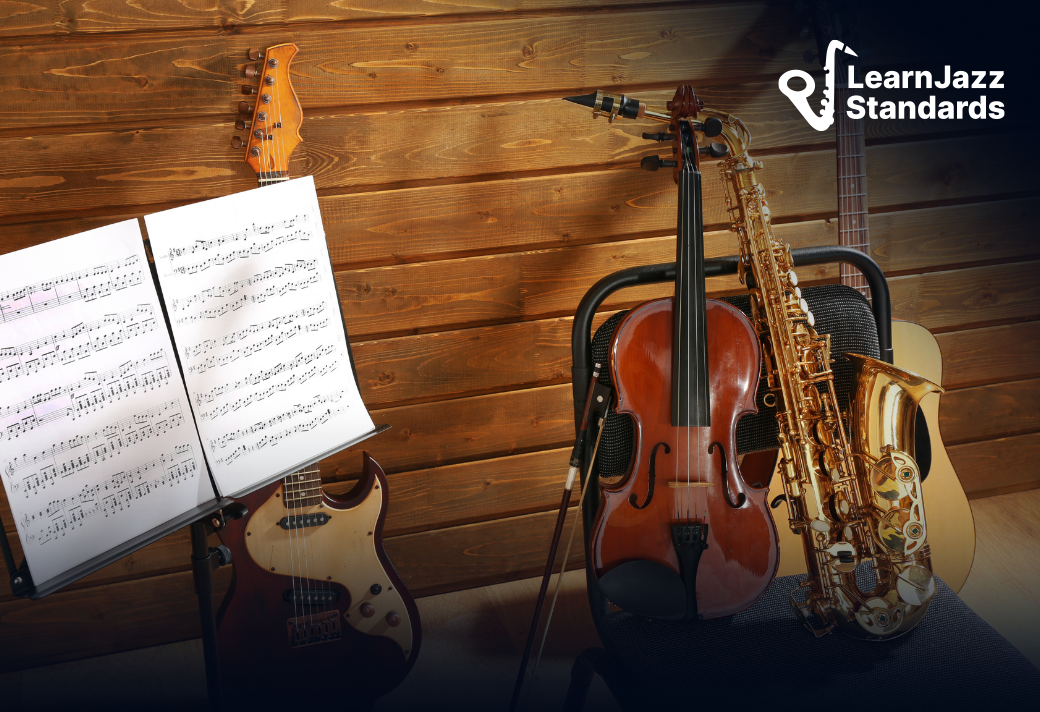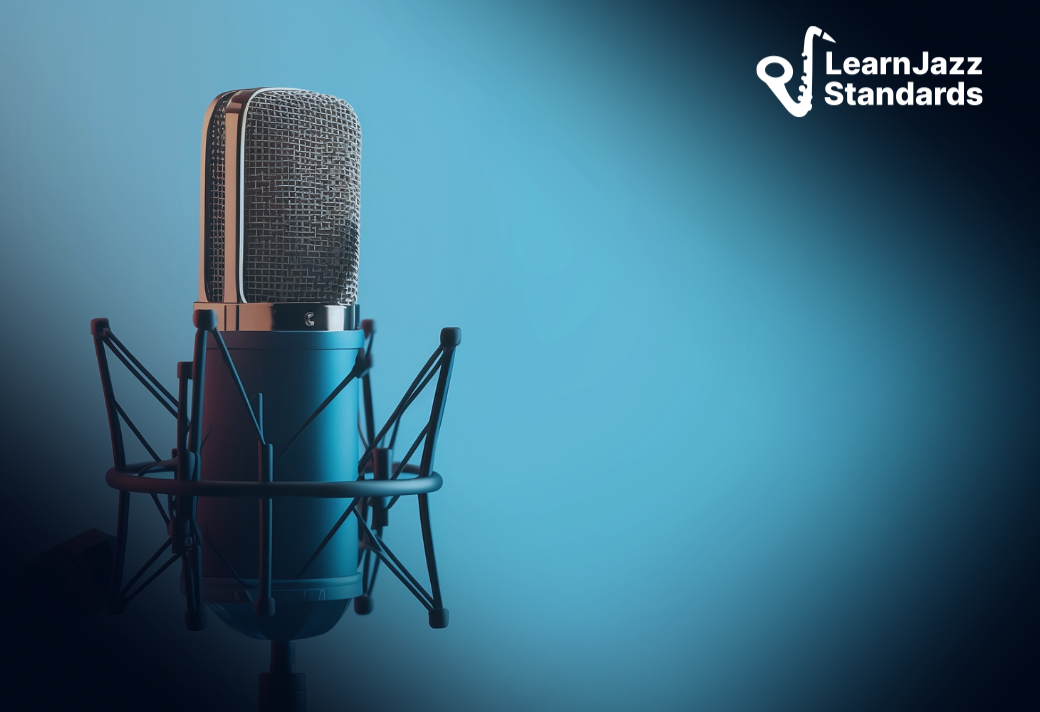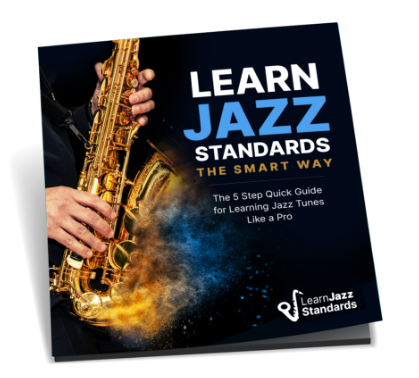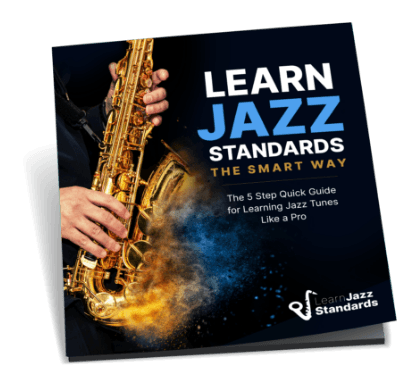There are so many jazz songs out there. When learning jazz, it’s hard to know where to start and which jazz songs are the most important to learn.
That’s why…
We’ve created this list to help you and other beginner jazz musicians filter out the most important jazz standards to help you improve your jazz repertoire, absorb important jazz language, and get a comprehensive look at all the important sub-genres within jazz.
Not only will these jazz songs help you out during a jam session or gig, but they will also strengthen your harmonic knowledge and improvisation skills.
If you don’t know any of these tunes, take advantage of everything Learn Jazz Standards has to offer!
Learn Jazz Standards has spent years and countless hours building up the essential resources to help you learn these important songs.
Plus, if you want one convenient place to learn jazz standards, improve your jazz chops, and network with a bunch of musicians who love learning jazz as much as you do, then you need to check out the Learn Jazz Standards Inner Circle.
When you join the Inner Circle, you’ll have everything you need to become the best jazz player you can be.
Come see what the Inner Circle is all about!
Table of Contents
What’s So Important About Learning Jazz Songs?
There are two main reasons why learning the following 50 jazz standards is crucial for your jazz education and development.
Jazz is a language, and jazz standards contain all the essential phrases, slang, vocabulary, and inflections you need in order to speak it fluently with other jazz musicians all over the world.
Jazz is a Language
Every city or region tends to have a different set of common jazz standards that jazz musicians will call. One city’s list may differ slightly from another, but there are certain tunes that are the standards among standards and can be called anywhere throughout the world.
The 50 jazz standards we’ve compiled are the “standards among standards” that will help you communicate better with other musicians on any gig or jam session.
The Snowball Effect
Are you familiar with the snowball effect?
A snowball starts off small, but as it rolls through the snow, it grows larger and larger. As it grows, its surface area increases, allowing it to pick up more and more snow. The more snow it accumulates, the more snow it is able to accumulate in the future.
Learning jazz standards works in exactly the same way. Many jazz standards are built from the same chord changes and progressions. In a sense, when you learn one jazz song, you are learning the parts of many other jazz songs.
Therefore, the more jazz standards you learn, the easier and easier it becomes for you to learn any jazz song.
The following 50 jazz standards contain many elements that appear in most songs throughout the jazz world. Though the key might change or the time signature may be different, the components of many jazz songs are the same.
Now, let’s dig into the 50 jazz standards every jazz musician needs to know.
50 Jazz Standards All Jazz Musicians Need to Know
In the following list of famous jazz tunes, we’ll include some important listening recommendations and other important bits of information jazz fans should know.
For an in-depth dive into these jazz songs, be sure to click through the links below:
1. All of Me
“All of Me” – Written by Gerald Marks and Seymour Simons.
This song became popular during the swing era and made it on the US pop charts via many different recording artists in the mid-20th century.
Louis Armstrong recorded a famous version that made it to the #1 spot on the US charts in 1931. The most famous version was recorded by Billie Holiday in 1941. Also, Frank Sinatra recorded this same tune various times throughout his career.
Check out:
- Louis Armstrong – “Home/All of Me” (1932)
- Count Basie and His Orchestra – “Frankly Basie: Count Basie Plays The Hits Of Frank Sinatra” (1963)
- Ella Fitzgerald – “Ella Swings Gently with Nelson (1993 reissue)” – (1961)
2. All The Things You Are
“All The Things You Are” – Written by Jerome Kern and Oscar Hammerstein II.
When it comes to learning jazz, “All The Things You Are” is a signature tune you need to know. Despite being written for a musical in 1939, this song became popular during the Bebop era, when many jazz musicians played the song with a faster tempo than vocal versions.
- Art Tatum and Ben Webster Quartet – All the Things You Are (1956)
- Bill Evans Trio on the album “At Shelly’s Manne-Hole” (1963)
- Dave Brubeck on the album “All the Things We Are” (1974)
3. Alone Together
“Alone Together” – Written by Arthur Schwartz and Howard Dietz.
This song, like many jazz standards, was written for a Broadway musical – Flying Colors (1932). However, many jazz instrumentalists have taken it and made it their own. This song became most popular during the cool jazz era.
- Dizzy Gillespie – “Alone Together / There Are Things I Love” (1951)
- Paul Desmond – “Take Ten” (1963)
- Bill Evans – “Live At The Trident Club” (1964)
4. Autumn Leaves
“Autumn Leaves” – Music by Joseph Kosma and lyrics by Jacques Prévert (French) and Johnny Mercer (English).
As far as jazz songs are concerned, Autumn Leaves may be the most famous tune on this list. This song became popular during the Hard Bop era and was originally a French song: “Les Feuilles Mortes.”
Listen to:
- Ahmad Jamal – “The Ahmad Jamal Trio” (1955)
- Cannonball Adderley – Somthin Else (1958)
- Sarah Vaughan – “Crazy And Mixed Up” (1982)
5. Billie’s Bounce
“Billie’s Bounce” – Written by Charlie Parker.
Every jazz musician needs to know several blues heads, and Billie’s Bounce is a great tune to start practicing a blues form that has more harmonic movement than a simple blues.
- Charlie Parker – “The Complete Savoy Sessions” (1945)
- Dizzy Gillespie – “To Bird with Love” (1992)
- George Benson – “Giblet Gravy” (1968)
6. Black Orpheus (Manhã de Carnaval)
“Black Orpheus” – Music by Luiz Bonfá and lyrics by Antônio Maria
There are several Latin jazz tunes on this list, and no tune list is complete without a few Latin or Bossa Nova tunes. As jazz songs go, “Black Orpheus” is a unique blend of South American and Ancient Greek folklore and Cool Jazz.
- Wayne Shorter – “Wayning Moments” (1961)
- Astrud Gilberto – “The Shadow of Your Smile” (1965)
- Paul Desmond – “Take Ten” (1963)
7. Blue Bossa
“Blue Bossa” – Written by Kenny Dorham.
Blue Bossa is another common jam session tune that is usually played fast with a Latin feel.
There are many great recordings of this tune, but a few notable ones are listed below.
- Joe Henderson – “Page One” (1963)
- Dexter Gordon – “Biting the Apple” (1976)
- Pat Martino – “Exit” (1976)
8. Body and Soul
“Body and Soul” – Written by Johnny Green, Edward Heyman, Robert Sour, and Frank Eyton.
This jazz song is a staple among ballads in the jazz tradition. The rich and intricate harmonic structure of “Body and Soul” offers an expansive landscape for improvisation. It’s certainly a favorite among many great players, from Coleman Hawkins to John Coltrane.
Be sure to check out:
- Coleman Hawkins – “Body and Soul” (1939)
- Billie Holiday – “Body and Soul” (1940)
- John Coltrane – “Coltrane’s Sound” (1960)
9. But Not For Me
“But Not For Me” – Written by Ira and George Gershwin.
This George and Ira Gershwin tune is a classic enshrined in the Great American Songbook. The swinging rhythm and witty yet melancholic lyrics evoke a bittersweet quality that’s typical of the Gershwins’ many jazz songs.
Be sure to check out:
- Chet Baker – “Chet Baker Sings” (1954)
- Ella Fitzgerald – “Ella Fitzgerald Sings the George and Ira Gershwin Songbook” (1959)
- Ahmad Jamal – “At the Pershing: But Not for Me” (1958)
10. Bye Bye Blackbird
“Bye Bye Blackbird” – Written by Ray Henderson and Mort Dixon
One of the emblematic songs from the Tin Pan Alley era, “Bye Bye Blackbird,” should be on your tune list. Its uplifting melody and simple harmonic structure offer an ideal foundation for improvisation.
Be sure to check out:
Miles Davis – “‘Round About Midnight” (1957)
John Coltrane – “Bye Bye Blackbird” (recorded 1962, released 1981)
Etta Jones – “Don’t Go to Strangers” (1960)
11. Cherokee
“Cherokee” – Written by Ray Noble.
With its rapid-fire chord changes and lively tempo, “Cherokee” by Ray Noble is a rite of passage for any musician. It’s a high-octane challenge, demanding technical proficiency, improvisational agility, and a deep sense of swing.
As the tune that inspired Charlie Parker to develop his bebop language, “Cherokee” stands as a milestone in the evolution of the genre, marking the shift from swing to bebop.
- Johnny Smith – “Moonlight in Vermont” (1952)
- Clifford Brown and Max Roach – “Study in Brown” (1955)
- Kamasi Washington – “The Epic” (2015)
12. Confirmation
“Confirmation” – Written by Charlie Parker
Charlie Parker’s “Confirmation” is a prime example of the intricate melodic lines and complex harmonies that characterize the bebop era. Its challenging chord changes and infectious swing feel have made it a favorite among musicians.
While it is one of the more challenging songs on this list, it offers endless opportunities for creative improvisation and is a must-know. Check out:
- Barry Harris and Kenny Barron – “Confirmation” (1992)
- Art Blakey – “A Night at Birdland Vol. 2” (1954)
- Dexter Gordon – “Daddy Plays the Horn” (1955)
13. Days of Wine and Roses
“Days of Wine and Roses” – Written by Henry Mancini and Johnny Mercer.
This gem from Henry Mancini is known for its delicate, lyrical melody and subtle harmonic complexity. The tune was written for the 1962 film of the same name and is an example of how cinematic music can be transformed into a jazz standard.
Be sure to check out:
- Ella Fitzgerald and Joe Pass – “Easy Living” (1986)
- Bill Evans and Tony Bennet – “Days Of Wine And Roses” (1975)
- Oscar Peterson – “We Get Requests” (1964)
14. Doxy
“Doxy” – Written by Sonny Rollins.
“Doxy” is a playful, melodic journey through simple blues changes. As a testament to Rollins’ fun and quirky style, this tune stands out for its catchy riff-based melody.
Be sure to check out:
- Sonny Rollins and Miles Davis – “Miles Davis with Sonny Rollins” (1954)
- Miles Davis – “Bag’s Groove” (1954)
- John Coltrane – “Like Sonny” (1960)
15. Fly Me To The Moon
“Fly Me To The Moon” – Written by Bart Howard.
This song made it onto the pop charts several times with many popular artists over the years.
This is one of the songs that embody the charisma and elegance of jazz. Its memorable melody, romantic lyricism, and accessible harmonic progression have made it a beloved standard in jazz and other music circles.
Be sure to check out:
- Frank Sinatra – “It Might As Well Be Swing” (1964)
- Joe Henderson – “Straight, No Chaser” (1968)
- Oscar Peterson – “We Get Requests” (1964)
16. Footprints
“Footprints” – Written by Wayne Shorter.
Wayne Shorter’s “Footprints” is a masterclass in jazz composition. With its haunting melody, asymmetric 6/4 time signature, and unique minor blues form, it pushes boundaries and invites a profound exploration of modal jazz.
Be sure to check out:
- Miles Davis – “Miles Smiles” (1966)
- Wayne Shorter – “Adam’s Apple” (1966)
- Pat Martino – “The Visit” (1972)
17. Four
“Four” – Written by Miles Davis.
This tune is a prime example of his knack for composing tunes that are as engaging as they are straightforward. The playful melody and fast tempo exemplify Davis’s cool and accessible approach to bebop.
“Four” offers an enjoyable challenge for musicians while serving as a solid introduction to jazz harmony.
Be sure to check out:
- Red Garland – “Red Garland Revisited!” (1969)
- Dexter Gordon – “Bouncin’ with Dex” (1976)
- Maynard Ferguson – “Maynard ’62” (1962)
18. Have You Met Miss Jones
“Have You Met Miss Jones” – Written by Richard Rodgers and Lorenz Hart.
This charming piece by Richard Rodgers and Lorenz Hart from the Swing Era is beloved for its catchy melody and unexpected harmonic complexity. The bridge’s sequence of key changes is a challenging exercise for jazz players.
Be sure to check out:
- Oscar Peterson – “We Get Requests” (1964)
- Benny Goodman – “Camel Caravan” (1937)
- Art Tatum – “The Art Tatum Solo Masterpieces Vol. 1” (1953)
19. How High The Moon
“How High The Moon” – Written by Morgan Lewis and Nancy Hamilton.
“How High The Moon” has become a must-know tune for modern musicians. The tune is often played at a brisk tempo. Charlie Parker’s famous bebop composition, “Ornithology,” is basically a new melody with the same changes (known as a contrafact).
Be sure to check out:
- Keely Smith – “I’m in Love Again” (1985)
- Bing Crosby – “El Señor Bing” (1960)
- Abbey Lincoln – “The World Is Falling Down” (1991)
20. I Hear a Rhapsody
“I Hear a Rhapsody” – Written by George Fragos, Jack Baker, and Dick Gasparre.
This tune has rich harmonies and a lyrical melody. Its intricate chord changes and structure embody the essence of 1940s pop music. This jazz song is a challenge to play at fast tempos due to the parallel minor seventh chords that move in minor thirds at the end of the A sections.
Check out:
- Chick Corea, Miroslav Vitous, and Roy Haynes – “Trio Music – Live in Europe” (1986)
- John Coltrane – “Lush Life” (1961)
- Art Blakey – “Art Blakey!!!!! Jazz Messengers!!!!!” (1961)
21. I Love You
“I Love You” – Written by Cole Porter.
This Cole Porter tune is a delight for both musicians and listeners. Originally written for a 1944 Broadway musical, it has since become a bona fide standard, often played at a brisk tempo.
“I Love You” offers a gratifying challenge to improvisers with its mixture of classic Broadway charm and harmonic complexity.
Be sure to check out:
- Mike Stern – “Give And Take” (1997)
- Oscar Peterson – “I Love You / Daahoud” (1962)
- Bill Evans – “New Jazz Conceptions” (1956)
22. I Remember You
“I Remember You” – Written by Victor Schertzinger and Johnny Mercer.
With its tender, catchy melody and heartfelt lyrics, this jazz song is often interpreted as a nostalgic ballad.
Be sure to check out:
- Björk – “Venus As A Boy” (1993)
- Chet Baker – “Chet Baker Sings and Plays With Bud Shank, Russ Freeman, and Strings” (1955)
- Sarah Vaughan – “I Remember You” (2003)
23. I’ll Remember April
“I’ll Remember April” – Written by Gene de Paul, Patricia Johnston, and Don Raye.
“I’ll Remember April” is known for its bright melody and lively harmonic progression. Often played at a brisk tempo, it is a staple in the bebop and mainstream repertoire and is a great vehicle for improvisation.
- Grant Green – “Standards” (1961)
- Jim Hall and Ron Carter – “Alone Together” (1973)
- Erroll Garner – “Concert by the Sea” (1955)
24. I’m Old Fashioned
“I’m Old Fashioned” – Written by Jerome Kern and Johnny Mercer.
This Jerome Kern and Johnny Mercer jazz song stands out as a quintessential ballad. Its lyrical melody, romantic lyrics, and elegant harmony invite musicians to take their time exploring its depths.
Be sure to check out:
- John Coltrane – “Blue Train” (1957)
- Paul Desmond – “Pure Desmond” (1975)
- Eileen Farrell – “I’ve Got a Right to Sing the Blues” (1960)
25. If I Should Lose You
“If I Should Lose You” – Written by Ralph Rainger and Leo Robin.
“If I Should Lose You” is a deeply emotive jazz standard. Composed by Ralph Rainger and Leo Robin, it serves as a perfect platform for heartfelt improvisation and is usually played as a melancholic ballad.
Be sure to check out:
- Sonny Stitt – “Sonny Stitt Plays” (1955)
- Shirley Horn – “Embers and Ashes” (1959)
- Chick Corea and Stefano Bollani – “Orvieto” (2010)
BEFORE YOU CONTINUE...
If you struggle to learn jazz standards by ear, memorize them, and not get lost in the song form, then our free guide will completely change the way you learn tunes forever.
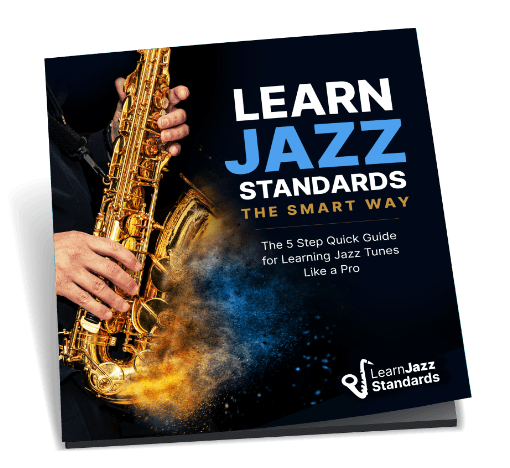
26. If I Were A Bell
“If I Were A Bell” – Written by Frank Loesser.
This Frank Loesser tune is a delightful romp with a playful melody and cheery lyrics. Its rhythmic buoyancy and standard harmonic structure make it an excellent vehicle for jazz improvisation.
Be sure to check out:
- Dinah Washington – “In the Land of Hi-Fi” (1956)
- Ella Fitzgerald – “Ella Swings Lightly” (1958)
- Miles Davis – “Relaxin’ with the Miles Davis Quintet” (1956)
27. In A Mellow Tone
“In A Mellow Tone” – Written by Duke Ellington and Milt Gabler.
This song became popular during the Swing era with a recording by Duke Ellington and his famous orchestra. “In A Mellow Tone” exhibits Ellington’s ability to meld sophisticated harmonies with an approachable and enjoyable melody.
- Count Basie – “Breakfast Dance and Barbecue” (1959)
- Joe Pass – “Portraits of Duke Ellington” (1975)
- Sonny Stitt – “Sonny Stitt with Strings: A Tribute to Duke Ellington” (1977)
28. In A Sentimental Mood
“In A Sentimental Mood” – Written by Duke Ellington and Irving Mills.
This tune is an evocative ballad known for its deeply emotional melody and harmonic richness. The tune invites musicians to delve into its poignant narrative, often resulting in expressive and introspective performances. Check out:
- Michael Brecker – “Magnetic” (1986)
- Michel Petrucciani, Jim Hall, and Wayne Shorter – “Power of Three” (1987)
- Johnny Mathis – “In a Sentimental Mood: Mathis Sings Ellington” (1990)
29. It Could Happen To You
“It Could Happen To You” – Written by Jimmy Van Heusen and Johnny Burke.
With its bright melody and uplifting lyrics, the song provides a buoyant backdrop for improvisation. Be sure to check out:
- Sonny Rollins – “Sound of Sonny” (1957)
- Bud Powell – “The Amazing Bud Powell, Vol. 1” (1951)
- Miles Davis – “Relaxin’ with the Miles Davis Quintet” – (1956)
30. Just Friends
“Just Friends” – Written by John Klenner and Sam M. Lewis.
A favorite among jazz instrumentalists, this tune by John Klenner and Sam M. Lewis is known for its strong, memorable melody and exciting chord changes. Be sure to check out:
- Pat Martino – “El Hombre” (1967)
- Dizzy Gillespie – “The Trumpet Summit Meets the Oscar Peterson Big 4” (1980)
- Sun Ra & His Arkestra – “Just Friends” (1983)
31. Misty
“Misty” – Written by Erroll Garner and Johnny Burke.
Misty is a beautiful ballad that has many amazing versions you should check out. This is one of the songs you’ll most likely play with a vocalist at some point. The chord progression and slow tempo allow young improvisers plenty of space to try new ideas while soloing.
Be sure to check out:
- Charles Mingus – “Jazz Club Presents Charles Mingus, Lionel Hampton, Earl ‘Fatha’ Hines” (2017)
- Count Basie – “Dance Along with Basie” (1959)
- Aretha Franklin – “Yeah!!!” (1965)
32. My Funny Valentine
“My Funny Valentine” – Written by Richard Rodgers and Lorenz Hart.
Known for its tender melody and humourous lyrics, this jazz song is a fun playground for instrumentalists and vocalists alike. Check out some of these renditions (yes, even Chaka Khan did a version).
- Keith Jarrett – “Still Live” (1988)
- Chet Baker – “Chet Baker Sings (1956 reissue)” – (1956)
- Chaka Khan – “Waiting to Exhale (Soundtrack)” (1995)
33. Night and Day
“Night and Day” – Written by Cole Porter.
The tune’s hypnotic melody and clever harmonic progressions invite musicians to explore its complex structure. This tune is a great vehicle for practicing transposing ideas in minor thirds.
Be sure to check out:
- Ella Fitzgerald – “Ella Fitzgerald Sings the Cole Porter Song Book” (1956)
- Bill Evans – “Everybody Digs Bill Evans” (1959)
- Morten Haxholm – “Equilibrium” (2019)
34. Oleo
“Oleo” – Written by Sonny Rollins.
Learning a rhythm changes tune is essential for playing at jam sessions! If you learn the changes to one rhythm changes tune, you (basically) learn the changes to all of them. Oleo is a great rhythm change head to learn because the melody isn’t too difficult.
Be sure to check out:
- Sonny Rollins and Miles Davis – “Miles Davis with Sonny Rollins” (1954)
- Pat Martino – “Desperado” (1970)
- Eric Dolphy – “Eric Dolphy In Europe, Vol. 1” (1989)
35. On Green Dolphin Street
“On Green Dolphin Street” – Written by Bronisław Kaper and Ned Washington.
This is a jazz standard known for its unique structure and catchy, swinging melody. It’s especially noted for its harmonic shifts between major and minor, providing a fun vehicle for improvisation.
Check out:
- Barney Kessel – “The Poll Winners” (1957)
- Chick Corea and Return to Forever – “Live” (1977)
- Grant Green – “Gooden’s Corner” (1961)
36. Recorda Me
“Recorda Me” – Written by Joe Henderson.
This tune’s contagious Latin groove, coupled with its strong melody and modern harmonic structure, offers musicians a gratifying challenge. Its fusion of jazz harmony with Afro-Cuban rhythms makes it a unique entry on this list.
Check out:
- Steps Ahead – “Smokin’ in the Pit” (1980)
- McCoy Tyner – “New York Reunion” (1991)
- Art Farmer – “Soul Eyes” (1991)
37. Satin Doll
“Satin Doll” – Written by Duke Ellington and Billy Strayhorn, lyrics by Johnny Mercer.
Often performed with a relaxed swing feel, the tune is a great exercise for musicians to stretch out and practice their jazz chops.
Notable versions include:
- Dr. John – “Duke Elegant” (1999)
- Hank Jones – “Someday My Prince Will Come” (2002)
- McCoy Tyner – “Nights of Ballads & Blues” (1963)
38. Stella By Starlight
“Stella By Starlight” – Written by Victor Young and Ned Washington.
Known for its hauntingly beautiful melody and complex harmonic progression, “Stella By Starlight” is one of the most revered standards in the jazz repertoire. Its rich harmonic language leads to creative and emotive improvisations.
Be sure to explore:
- Robert Glasper – “Covered” (2015)
- Ray Charles – “Dedicated to You” (1961)
- Vic Juris – “Vic Plays Victor Young” (2016)
39. Scrapple From The Apple
“Scrapple From The Apple” – Written by Charlie Parker.
This tune is a quintessential bebop composition. Known for its fast-paced melody and rhythmic complexity, “Scrapple From The Apple” is a challenging yet stimulating playground for improvisation.
Check out:
- Curtis Fuller – “Jazz Conference Abroad” (1962)
- Dexter Gordon – “Our Man in Paris” (1963)
- Jim Hall – “Jim Hall Live!” (1975)
40. So What
“So What” – Written by Miles Davis.
As the opening track of Miles Davis’s revolutionary album “Kind of Blue,” “So What” is a pillar of modal jazz. The tune, known for its sparse melodic theme and modal harmonic structure, encourages musicians to explore beyond traditional chord-scale relationships.
Check out:
- Miles Davis – Kind of Blue (1959)
- Miles Davis – ”Four’ & More: Recorded Live in Concert” (1964)
- Miles Davis and John Coltrane – “Miles Davis & John Coltrane The Final Tour” (2018)
41. Solar
“Solar” – Written by Miles Davis.
“Solar” showcases Miles’s knack for composing tunes that are as engaging as they are straightforward. Its catchy theme and unique chord changes have made it a favorite of music lovers.
Check out:
- Miles Davis – “Miles Davis Quintet” (1954)
- Pat Metheny, Dave Holland, Roy Haynes – “Question And Answer” (1990)
- Bill Evans – “Sunday At The Village Vanguard” (1961)
42. St. Thomas
“St. Thomas” – Written by Sonny Rollins.
This tune is one of the most famous examples of the fusion between jazz and Caribbean rhythms. With its catchy, calypso-inspired melody and straightforward chord changes, “St. Thomas” provides a lively and refreshing platform for improvisation.
Check out:
- Sonny Rollins – “Saxophone Colossus” (1956)
- Ron Carter and Jim Hall – “Alone Together” (1972)
- Dallas Original Jazz Orchestra – “Where There’s Smoke” (2009)
43. Sweet Georgia Brown
“Sweet Georgia Brown” – Written by Ben Bernie, Maceo Pinkard, and Kenneth Casey.
Whether it’s interpreted in a traditional Dixieland style or given a modern twist, “Sweet Georgia Brown” always brings an invigorating burst of energy to any performance.
Check out:
- Django Reinhardt & Stephane Grappelli – “Django Reinhardt and Stéphane Grappelli” (2005)
- Art Tatum – “God is in the House” (1973)
- Charlie Parker, Lester Young, and Dizzy Gillespie – “Early Modern: 1946 Concert Recordings” (1971)
44. Take The A Train
“Take The A Train” – Billy Strayhorn
“Take The A Train” is a jazz music staple! Billy Strayhorn’s clever songwriting and harmonically sophisticated style are evident in this jazz song’s catchy melody and distinctive rhythmic motif. It perfectly captures the essence of the Duke Ellington Orchestra’s sound.
Listen to:
- Clifford Brown with Max Roach – “Study in Brown” (1955)
- Ella Fitzgerald – “Ella Fitzgerald Sings the Duke Ellington Song Book” (1957)
- Anita O’Day – “Anita O’Day Sings the Winners” (1958)
45. The Girl From Ipanema
“The Girl From Ipanema” – Antonio Carlos Jobim and Vinicius de Moraes, English lyrics by Norman Gimbel.
Composed by Antonio Carlos Jobim, this bossa nova classic helped popularize Brazilian music in the US in the 1960s. Its sensual melody, laid-back groove, and evocative lyrics have made it one of the more beloved jazz songs worldwide.
Listen to:
- Stan Getz and João Gilberto – “Getz/Gilberto” (1964)
- Frank Sinatra and Carlos Antonio Jobim – “Francis Albert Sinatra and Carlos Antonio Jobim” (1967)
- Oscar Peterson – “We Get Requests” (1964)
46. There Is No Greater Love
“There Is No Greater Love” – Written by Isham Jones and Marty Symes.
This Isham Jones and Marty Symes tune showcases the romantic side of the jazz tradition. Known for its sweet melody and simple yet effective chord changes, it provides a platform for both lyrical and up-tempo improvisation.
Check out:
- Ahmad Jamal – “At the Pershing: But Not for Me” (1958)
- Amy Winehouse – “Frank” (2003)
- Nat King Cole – “The Very Thought of You” (1958)
47. There Will Never Be Another You
“There Will Never Be Another You” – Written by Harry Warren and Mack Gordon.
Known for its upbeat melody and harmonically satisfying progression, it’s a blast to improvise over. This is another must-know tune.
Be sure to listen to:
- Chet Baker – “Chet Baker Sings (1956 reissue)” – (1956)
- Nat King Cole – “Nat King Cole Sings for Two in Love” (1955)
- Wynton Kelly Trio – “Piano Interpretations” (1951)
48. Up Jumped Spring
“Up Jumped Spring” – Written by Freddie Hubbard.
This Freddie Hubbard composition stands as a testament to his talent not only as a trumpeter but also as a composer. With its buoyant melody and unique harmonic structure, it offers a delightful challenge for improvisation, highlighting the more playful and imaginative side of the genre.
- Curtis Fuller – “Up Jumped Spring” (2003)
- Benny Golson – “Up Jumped Benny” (1997)
- Freddie Hubbard – “Backlash” (1967)
49. What Is This Thing Called Love
“What Is This Thing Called Love” – Written by Cole Porter.
This tune is another staple of jam sessions. Its catchy melody and sophisticated harmonic changes have made it a beloved standard for jam sessions, often performed way up.
Check out:
- Joe Henderson – “Straight, No Chaser” (1968)
- Cannonball Adderley – “At the Lighthouse” (1960)
- Bobby McFerrin and Herbie Hancock – “The Other Side of ‘Round Midnight” (1986)
50. Yesterdays
“Yesterdays” – Written by Jerome Kern and Otto Harbach.
“Yesterdays” is an evocative ballad performed in a minor key. Its haunting melody and complex harmonic structure provide a compelling platform for heartfelt improvisation.
Check out:
- Buddy Rich and Max Roach – “Rich vs. Roach” (1959)
- Clifford Brown – “Clifford Brown with Strings” (1955)
- Stephane Grappelli and Yehudi Menuhin – “Tea for Two” (1977)
Are These 50 Jazz Songs The Best Jazz Songs?
No! There are so many incredible jazz songs out there. Trimming the list to a modest fifty means ignoring so many great jazz songs. From John Coltrane’s “Giant Steps” to Louis Armstrong’s version of “What A Wonderful World” and beyond, many incredible jazz songs were not included on this list…
…And it’s not because they aren’t great!
To truly expose yourself to all the best jazz songs, you should listen to all the albums listed under each entry. That will give you a greater picture of all the best jazz songs out there.
Let’s do the math: 50 jazz songs X three suggested albums for each jazz song = 150 albums!
There are simply too many types of jazz music to create a simple “best jazz songs” list.
At a certain level, the “best jazz songs” comes down to personal preference. That’s why you should go make your own 50 best jazz songs list and compare it to this one!
Your list might include the Horace Silver tune “Song For My Father” or the Lee Morgan tune “The Sidewinder.” You might prefer more Jaco Pistorious and less Frank Sinatra. Your list will depend on your personal jazz music preferences.
Your “best jazz songs” list might include soul jazz, smooth jazz, or other subgenres instead of bebop or hard bop, and it wouldn’t be wrong.
How Many of These Jazz Standards Do You Know?
This list contains everything you need to learn jazz standards. If you memorize the chord changes and new melodies of these great American songbook classics, you’ll be well on your way to understanding jazz harmony, jazz music theory, and improvisational language.
Already know every popular jazz standard on this list? Have you already battle-tested these songs at your last local jam session?
Your journey is not over—visit our index to view an even larger list of songs.
Master Jazz Standards And Become the Best Jazz Musician You Can Be—Join The Learn Jazz Standards Inner Circle
If you are ready to get serious about learning jazz standards (and want to have a blast doing so), then you need to check out the Inner Circle.
When you join the Inner Circle, you’ll get instant access to years and years of jazz resources LJS has developed, as well as a deep dive into a new jazz standard every month. The Inner Circle is perfect for players who want to take their jazz chops, tune repertoire, and music theory knowledge to the next level.


